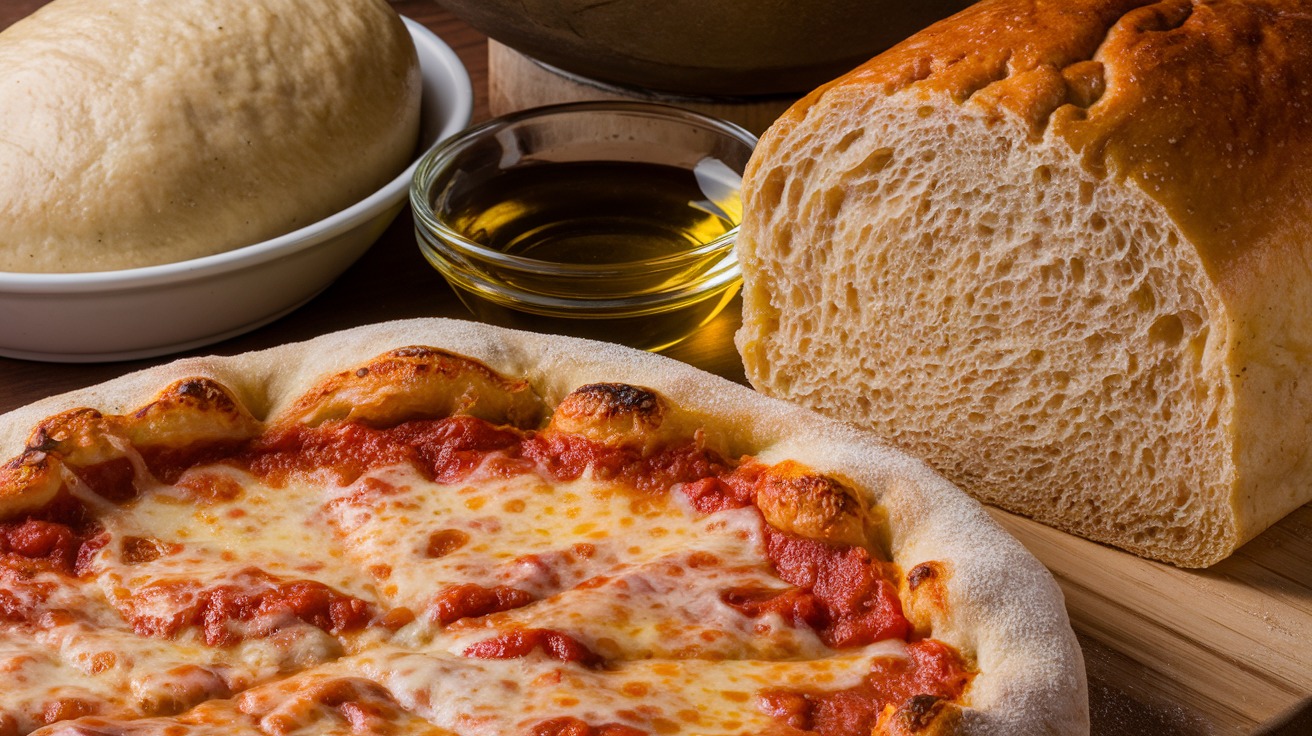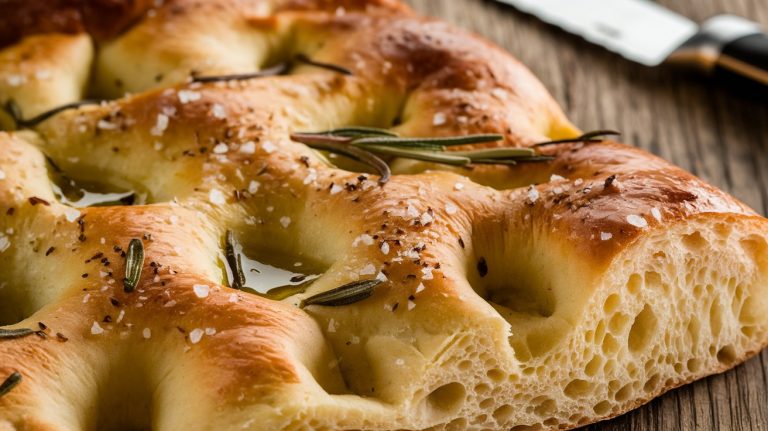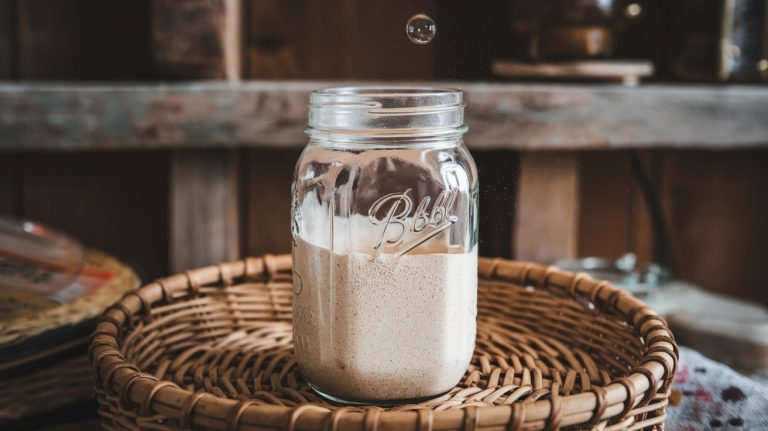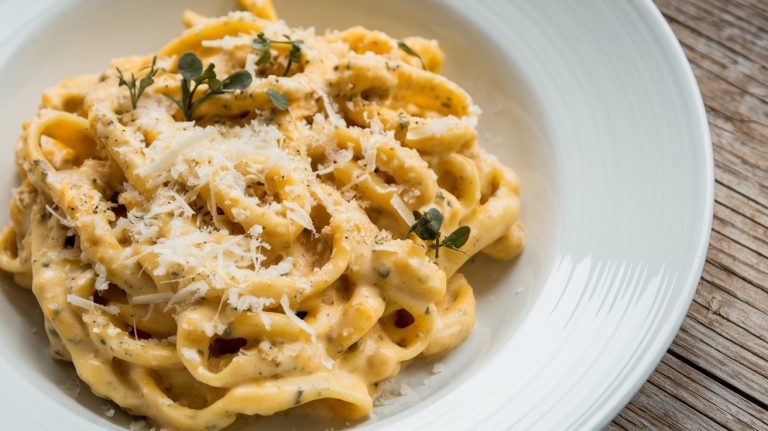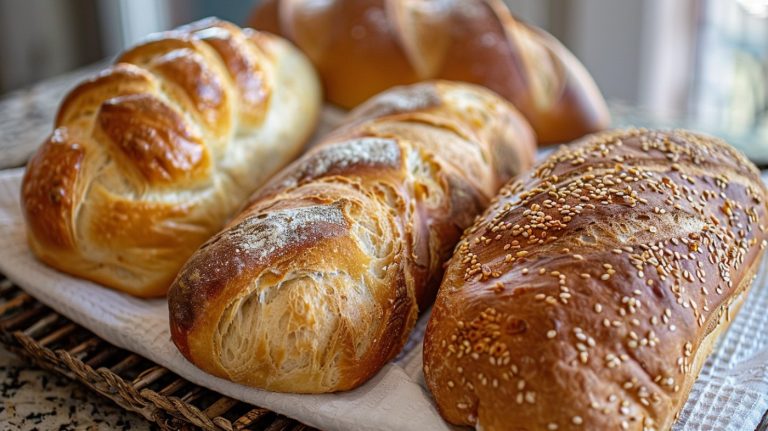Pizza Dough Vs Bread Dough: Exploring Dough Variations
Pizza dough and bread dough differ primarily in ingredients, hydration levels, and fermentation techniques. You’ll find pizza dough typically uses high-protein flour, with lower hydration (50-70%), resulting in a chewy crust.
In contrast, bread dough incorporates fats like butter and uses higher hydration (around 90%) for a softer, airier texture. The fermentation period also varies, with pizza dough rising quickly while bread dough benefits from longer fermentation to develop flavor.
These distinctions affect their final textures and cooking methods. If you want to explore how these differences influence your baking, there’s much more to uncover.
Key Takeaways
- Pizza dough typically has lower hydration (50%-70%) for a chewier crust, while bread dough has higher hydration (around 90%) for a softer texture.
- Pizza dough uses high-protein flour for strong gluten development, whereas bread dough may use lower-protein flour for a gentler texture.
- Fermentation times differ, with pizza dough rising for 1-2 hours, while bread dough benefits from longer fermentations for enhanced flavor complexity.
- Cooking methods vary; pizza is baked at high temperatures (750-1000°F) for a crispy crust, while bread is baked at lower temperatures (350-475°F) for softness.
- Flavor profiles differ, with pizza dough offering a savory, tangy taste and bread dough typically being sweeter and denser, especially in artisanal varieties.
Ingredients and Composition
When comparing pizza dough and bread dough, the differences in ingredients and composition play an essential role in their respective characteristics. A typical pizza dough recipe includes flour, water, salt, and a leavening agent, with minimal additional ingredients.
In contrast, bread dough often incorporates eggs, butter, cream, and sugar to enhance flavor and texture.
The hydration level is another significant factor; pizza dough generally ranges from 50% to 70%, whereas bread dough can reach around 90%. This difference leads to variations in flexibility and texture, vital for each type’s final product.
Additionally, pizza dough usually has a lower fat content compared to bread dough, which relies on added fats for flavor and structural integrity.
For achieving the desired crust texture, high-protein flour is favored in pizza dough to promote gluten development, resulting in a chewy crust.
On the other hand, bread dough can utilize lower protein flour for a softer texture.
Hydration Levels
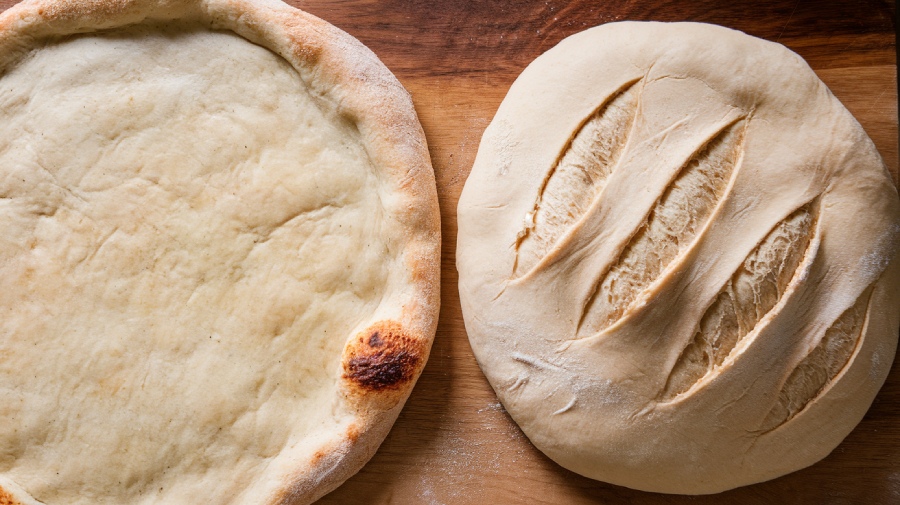
The differences in hydration levels between pizza dough and bread dough greatly affect their handling and final textures.
Pizza dough typically has a hydration level ranging from 50% to 70%, which allows it to achieve a crispy crust when baked at high temperatures. In contrast, bread dough can reach approximately 90% hydration, resulting in a softer texture and greater airiness during baking.
For instance, sourdough pizza crust generally sits around 63% hydration, while sourdough bread usually hovers at 71%. This difference in hydration levels considerably impacts the water-to-flour ratio, which ultimately influences the final product’s chewiness and flexibility.
Understanding these hydration levels is essential for achieving the desired texture and characteristics in both pizza and bread, whether you’re aiming for that perfect crispy crust or a soft, airy loaf. Additionally, utilizing sourdough discard for pizza can enhance the flavor profile, making the crust even more delicious.
On the other hand, higher hydration levels in bread dough lead to a more open crumb structure, providing better expansion and a lighter feel.
Gluten Development
Achieving ideal gluten development is essential for both pizza and bread dough, as it directly influences their texture and handling properties.
For pizza dough, you’ll want to use high-protein flour to create a robust gluten network. This strong gluten formation provides the necessary extensibility and stretch, resulting in that coveted chewy crust. The kneading process for pizza dough is typically more vigorous, ensuring that the gluten develops adequately to withstand toppings and cooking temperatures.
In contrast, bread dough may use a lower protein flour, allowing for a softer texture rather than extreme elasticity. While gluten development is still important for bread, the kneading process often focuses on gentler techniques or autolyse methods to achieve an airy structure.
The hydration levels also play a critical role; pizza dough usually contains between 50% to 70% hydration, while bread dough can reach up to 90%. This variation affects gluten formation and ultimately determines the final texture of your loaf or pizza.
Fermentation Times
Understanding gluten development naturally leads you to contemplate fermentation times, which play a significant role in the final texture and flavor of both pizza and bread dough.
Pizza dough typically requires a shorter fermentation time, around 1 to 2 hours when using commercial yeast. This allows for a quick rise, making it ideal for those who want a fast meal. In contrast, bread dough often benefits from several hours to overnight fermentation, which promotes optimal flavor development and texture. This extended time allows for the creation of steam, which is essential for achieving a crusty exterior and a well-developed crumb structure in sourdough bread.
When you’re working with sourdough, be prepared for longer fermentation times. Sourdough pizza dough can take 12 to 24 hours, enhancing both flavor and texture through slow fermentation. High hydration bread doughs also thrive on extended fermentation, as the increased moisture facilitates better gluten development and complexity in flavor.
Additionally, a second rise of about 10 to 15 minutes after shaping your pizza dough can enhance the crust’s thickness and chewiness. This contrasts sharply with many bread recipes that involve multiple rises to achieve an airy texture.
Cooking Techniques
Cooking techniques greatly influence the outcomes of both pizza and bread dough, each requiring specific methods to achieve their desired textures and flavors.
For pizza dough, you typically bake at high temperatures, ranging from 750-1000°F, which helps create a crispy crust. In contrast, bread dough is baked at lower temperatures, between 350-475°F, resulting in a softer texture.
Thin-crust pizzas cook quickly due to their low moisture content, while thicker bread-based pizzas need more time to cook through. Utilizing a pizza stone or baking steel can enhance crust quality by providing consistent high heat, a characteristic less common in standard bread baking methods.
For deep-dish or pan-style pizzas, incorporating oil into the cooking method allows the dough to fry slightly, yielding a breadier texture.
The technique of stretching and shaping pizza dough is essential; immediate cooking post-rolling produces a cracker-like crust, whereas bread dough benefits from resting and a longer rise for best flavor development.
Alternative Uses
When you think about pizza and bread dough, consider their potential beyond typical dishes.
Pizza dough can be transformed into cheese twists or sourdough pizza rolls, while bread dough easily morphs into cinnamon rolls or garlic knots.
Both types of dough showcase remarkable versatility, serving as bases for a variety of creative culinary applications.
Creative Pizza Dough Recipes
Pizza dough isn’t just for traditional pizzas; it can be transformed into a variety of creative dishes that elevate your culinary repertoire. One popular option is cheese twists. Simply roll out your pizza dough, add cheese and spices, twist it, and bake until golden brown for a delicious snack.
Additionally, you can use pizza dough to create fluffy focaccia that serves as a delightful side dish or appetizer.
For a fun appetizer, consider sourdough pizza rolls. Combine your pizza dough with fillings like pepperoni and cheese, roll it into pinwheels, and bake. These are perfect for parties or gatherings.
Another fantastic use for pizza dough is in seasoned flatbreads. Roll out the dough, brush it with olive oil, and sprinkle herbs and spices before baking. This creates a flavorful side dish that pairs well with many meals.
Calzones are another excellent choice, allowing you to encase a variety of fillings like ricotta, mozzarella, and vegetables within the dough, then bake them for a portable meal.
Similarly, pizza pockets can be made by filling the dough with ingredients such as ham and cheese and folding and sealing them for a convenient handheld option.
Versatile Bread Dough Applications
While pizza dough offers a wealth of creative possibilities, bread dough also boasts remarkable versatility that can enhance your baking skills. You can transform basic bread dough into a range of delicious recipes, showcasing its adaptability in the kitchen.
For example, you can create sweet cinnamon rolls by rolling out the dough, sprinkling a mixture of brown sugar and cinnamon, and baking until golden. Additionally, consider making soft, fluffy sourdough sandwich bread that serves as an excellent base for any meal; this bread provides enhanced digestibility due to natural fermentation.
If you’re in the mood for something savory, shape the dough into garlic knots by cutting it into small pieces, tying them into knots, and baking them with garlic butter for a mouthwatering appetizer.
Bread dough can also serve as the foundation for deep-dish pizza. Line a pan with the dough, fill it with layers of cheese, toppings, and sauce, and bake to perfection for a hearty meal. Additionally, you can craft soft, fluffy burger buns by portioning and shaping small rounds of dough, which is ideal for sandwiches.
Lastly, consider making monkey bread, a fun pull-apart pastry. Cut the dough into pieces, coat them in cinnamon sugar, and bake in a bundt pan for an irresistible dessert.
Swapping Doughs
Swapping pizza dough for bread dough greatly impacts both texture and flavor.
You’ll notice that bread dough creates a softer, biscuit-like crust, while pizza dough retains its characteristic chewiness.
Additionally, the added sugars and fats in bread dough can alter the overall taste of your pizza, making experimentation with ingredient ratios essential for achieving your desired outcome.
Texture Differences Explained
When you consider the differences in texture between pizza and bread dough, the hydration levels play a crucial role. Pizza dough typically has lower hydration levels, ranging from 50% to 70%, which results in a chewier crust.
In contrast, bread dough can reach approximately 90% hydration, yielding a softer, airier texture. When you swap these doughs, using bread dough for pizza often leads to a denser, breadier result with a softer crust that lacks the desired crispy exterior. Conversely, pizza dough offers a more structured loaf, but it may turn out thinner and less robust.
The gluten development in pizza dough is more extensive, contributing to its elasticity and stretch, essential for achieving that ideal pizza texture. This contrasts with bread dough, which can produce a less crispy crust due to its higher fat and sugar content.
Additionally, cooking methods heavily influence texture differences; pizza is baked at much higher temperatures (750-1000°F) than bread (350-475°F). This disparity contributes to the crispy exterior of pizza while ensuring a tender crumb for bread, further highlighting the significance of dough selection in achieving the desired texture.
Flavor Profile Variations
The choice of dough impacts texture and greatly alters the final product’s flavor profile. When you swap pizza dough for bread dough, you might notice a shift in taste and texture. For instance, pizza dough typically has lower hydration levels (50%-70%) than bread dough, which can reach up to 90%. This difference creates a thinner, crispier crust versus a softer, chewier one.
Here’s a quick comparison:
| Dough Type | Flavor Profile Variations |
|---|---|
| Pizza Dough | Savory, slightly tangy, less sweet |
| Bread Dough | Sweeter, buttery, denser (especially artisanal) |
| Sourdough Bread | Tangy, with complex fermentation notes |
| White Bread Dough | Mild, less chewy, softer texture |
Using bread dough for pizza can introduce a sweeter, buttery flavor due to added sugar and fat. Alternatively, utilizing sourdough bread dough can impart a distinctive tanginess, contrasting with traditional pizza dough.
Personal Preferences
Personal preferences in pizza crust reflect a wide array of tastes and textures that can make or break the overall dining experience. When it comes to pizza dough versus bread dough, choices vary greatly.
You might lean toward a thin and crispy crust pizza, or perhaps you enjoy a thick and chewy base. Each type of dough offers distinct characteristics influenced by fermentation time and the choice of ingredients.
For instance, utilizing a sourdough discard pizza crust can add unique flavors and nutrition to your pizza, showcasing how fermentation impacts taste. Many enthusiasts argue that smaller fermentation bubbles in the dough contribute to a superior crust quality, enhancing the texture and overall flavor profiles.
The definition of “good pizza” is subjective, with some valuing a hint of sweetness and a full wheat essence, while others prioritize a rich, savory experience. Experimenting with various types of dough, including artisanal bread dough, can lead to unique and delightful results tailored to your personal preferences.
Frequently Asked Questions
Is Pizza Crust Dough the Same as Bread Dough?
Think of dough as a chameleon—its form changes with purpose.
Pizza crust dough isn’t the same as bread dough, though they share ingredients. Pizza dough has lower hydration, which gives it that chewy texture, while bread dough is softer and airier due to higher hydration and additional ingredients.
The fermentation times also differ, with pizza dough rising quickly.
What Happens if You Use Bread Flour for Pizza Dough?
When you use bread flour for pizza dough, you enhance gluten development due to its higher protein content. This results in a chewier, more elastic crust that some prefer.
However, you may need to adjust the water-to-flour ratio because bread flour can absorb more moisture.
The thicker crust you achieve can feel more substantial, but the flavor will largely depend on your fermentation process and toppings, remaining similar to traditional pizza.
Can You Use Store-Bought Bread Dough for Pizza?
Yes, you can use store-bought bread dough for pizza.
Just remember, it’ll result in a chewier crust due to higher hydration levels. Roll the dough out thinner to avoid a dense texture.
If you pre-bake it, expect a softer base that may lack crispiness.
Keep in mind that the flavor might be sweeter and richer because of added sugars and fats, so adjust your baking times and temperatures accordingly for the best results.
Can You Use Bread Yeast for Pizza Dough?
Using bread yeast for pizza dough is like using a hammer when you need a screwdriver; it works, but you’ll notice differences.
Bread yeast can ferment and rise effectively, but it requires a longer time to do so, affecting your crust’s texture and flavor.
To achieve the best results, adjust the rising time and consider a lower hydration level to prevent a soggy crust.
Experimenting can lead to tasty outcomes, so don’t hesitate!
Chewy Crusts vs. Airy Loaves
In the culinary landscape, pizza dough and bread dough are like two dancers in a duet, each with its own rhythm and grace. Understanding their unique characteristics—ingredients, hydration, gluten, and fermentation—allows you to craft the perfect dish.
Whether you’re twirling a slice of pizza or savoring a warm loaf, knowing when to swap or adapt these doughs enhances your cooking repertoire. So, embrace their differences and let your creativity rise like a perfectly baked crust.

